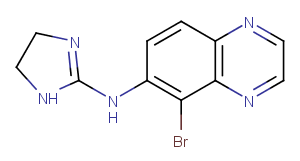Powder: -20°C for 3 years | In solvent: -80°C for 1 year


Brimonidine (Bromoxidine) is a drug used as eye drops under the brand names Alphagan and Alphagan-P. It is used to treat open-angle glaucoma or ocular hypertension

| Pack Size | Availability | Price/USD | Quantity |
|---|---|---|---|
| 5 mg | In stock | $ 52.00 | |
| 10 mg | In stock | $ 89.00 | |
| 25 mg | In stock | $ 183.00 | |
| 50 mg | In stock | $ 356.00 | |
| 100 mg | In stock | $ 529.00 | |
| 500 mg | In stock | $ 1,180.00 | |
| 1 mL * 10 mM (in DMSO) | In stock | $ 58.00 |

| Description | Brimonidine (Bromoxidine) is a drug used as eye drops under the brand names Alphagan and Alphagan-P. It is used to treat open-angle glaucoma or ocular hypertension |
| In vitro | [3H]Brimonidine is a full agonist at alpha 2-adrenergic receptors labeling at least 2 specific binding sites in the human brain that both have the characteristics of an alpha 2-adrenergic binding site. GTP decreases agonist binding at both of these sites, but with different potencies at each site [1]. |
| Synonyms | AGN190342, Bromoxidine, AGN 190342, AGN-190342 |
| Molecular Weight | 292.13 |
| Formula | C11H10BrN5 |
| CAS No. | 59803-98-4 |
Powder: -20°C for 3 years | In solvent: -80°C for 1 year
DMSO: 26 mg/mL (89.0 mM)
You can also refer to dose conversion for different animals. More
bottom
Please see Inhibitor Handling Instructions for more frequently ask questions. Topics include: how to prepare stock solutions, how to store products, and cautions on cell-based assays & animal experiments, etc.
Brimonidine 59803-98-4 GPCR/G Protein Neuroscience Adrenergic Receptor Beta Receptor AGN190342 UK14304 inhibit Bromoxidine UK 14304 AGN 190342 Inhibitor AGN-190342 UK-14304 inhibitor
